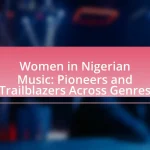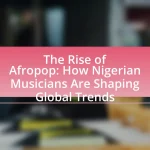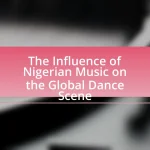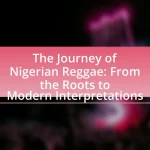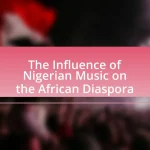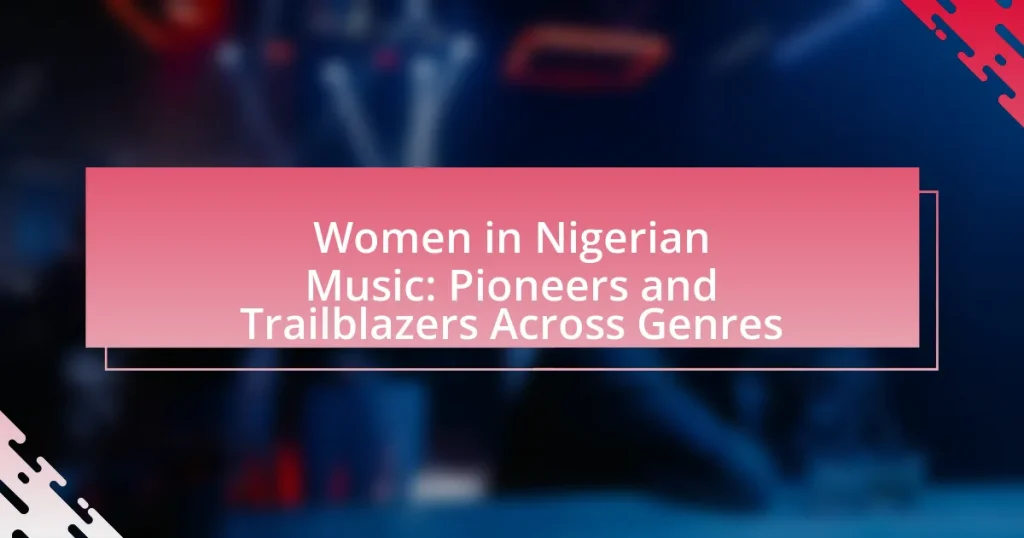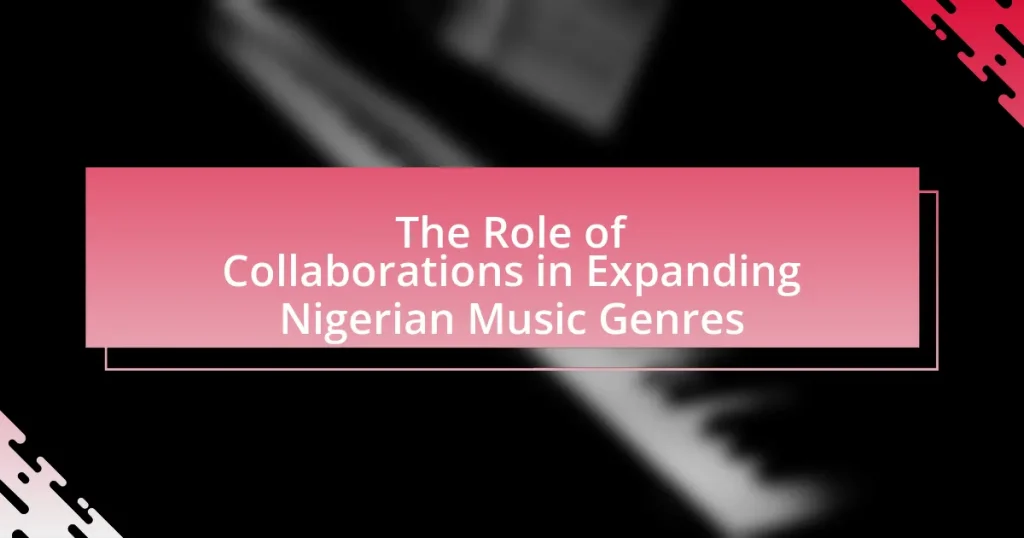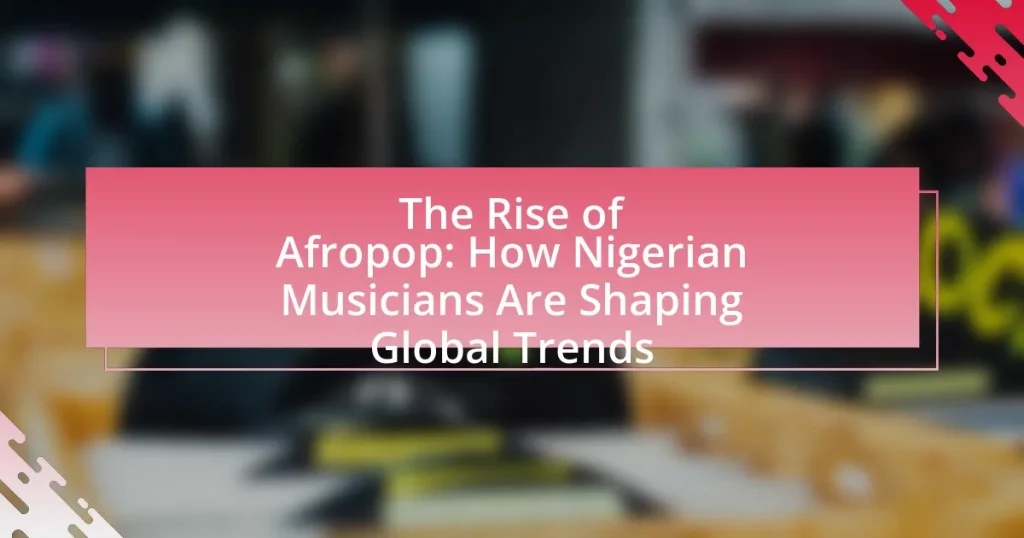The main entity of the article is the intersection of fashion and music within Nigeria’s hip hop scene. The article explores how Nigerian hip hop artists utilize fashion as a means of self-expression and cultural identity, blending traditional attire with contemporary styles to influence trends and resonate with audiences. It discusses the evolution of the hip hop genre in Nigeria, the historical influences shaping its culture, and the impact of local and global trends on music and fashion. Additionally, the article highlights the role of fashion in enhancing artists’ public personas, the significance of collaborations between musicians and designers, and the challenges faced by artists in merging these two creative domains.

What is the Intersection of Fashion and Music in Nigeria’s Hip Hop Scene?
The intersection of fashion and music in Nigeria’s hip hop scene is characterized by a dynamic relationship where artists use fashion as a form of self-expression and cultural identity. Nigerian hip hop artists often incorporate traditional attire, contemporary streetwear, and luxury brands into their performances and music videos, reflecting both local culture and global trends. For instance, artists like Wizkid and Olamide frequently showcase unique styles that blend African prints with modern fashion, influencing fans and setting trends within the industry. This synergy not only enhances their musical persona but also drives the fashion industry in Nigeria, as fans emulate their styles, leading to a vibrant street fashion culture that is closely tied to the music scene.
How has Nigeria’s hip hop scene evolved over the years?
Nigeria’s hip hop scene has evolved significantly from the early 1990s to the present day, transitioning from a niche genre to a dominant force in the African music landscape. Initially influenced by American hip hop, Nigerian artists began to incorporate local languages, cultural themes, and traditional sounds, leading to the emergence of a unique style that resonates with the local audience.
By the early 2000s, artists like 2Baba and D’banj popularized the genre, blending hip hop with Afrobeats, which further expanded its reach. The rise of digital platforms in the 2010s facilitated the global dissemination of Nigerian hip hop, allowing artists such as Wizkid and Olamide to gain international recognition.
The integration of fashion into the hip hop culture has also played a crucial role in its evolution, with artists using style as a form of self-expression and branding. This intersection has led to collaborations with fashion designers and the establishment of streetwear trends that reflect the vibrant Nigerian culture.
Overall, the evolution of Nigeria’s hip hop scene is marked by its ability to adapt and innovate, making it a significant player in the global music industry.
What historical influences shaped the current hip hop culture in Nigeria?
The current hip hop culture in Nigeria has been shaped by several historical influences, including the impact of colonialism, the rise of indigenous music genres, and the globalization of music. Colonialism introduced Western musical forms, which blended with local traditions, creating a unique sound. The emergence of indigenous genres like Afrobeat and Highlife in the mid-20th century provided a foundation for hip hop artists to draw from, incorporating local rhythms and themes. Additionally, the globalization of music in the late 20th century, facilitated by technology and the internet, allowed Nigerian artists to access and integrate international hip hop styles, further enriching the local scene. These influences collectively contributed to the vibrant and diverse nature of Nigeria’s hip hop culture today.
How do local and global trends impact Nigerian hip hop?
Local and global trends significantly shape Nigerian hip hop by influencing its sound, style, and cultural relevance. The infusion of international genres like trap and Afrobeat has led to a hybridization of musical styles, making Nigerian hip hop more appealing to a global audience. For instance, artists such as Burna Boy and Wizkid have successfully integrated elements of hip hop into their music, gaining international recognition and expanding the genre’s reach. Additionally, local trends, such as the rise of street fashion and indigenous languages in lyrics, reflect the socio-political landscape of Nigeria, allowing artists to resonate with local audiences while also appealing to global listeners. This dual influence fosters a dynamic music scene that continuously evolves, driven by both local cultural expressions and global musical innovations.
What role does fashion play in Nigeria’s hip hop culture?
Fashion plays a crucial role in Nigeria’s hip hop culture by serving as a form of self-expression and identity for artists and fans alike. It reflects social status, creativity, and cultural heritage, often incorporating traditional Nigerian elements alongside contemporary styles. For instance, artists like Olamide and Wizkid frequently showcase unique fashion choices that blend local fabrics with global trends, influencing youth culture and fashion trends across the country. This interplay between fashion and music not only enhances the visual appeal of performances but also solidifies the artists’ brand identities, making fashion an integral part of the hip hop narrative in Nigeria.
How do hip hop artists use fashion as a form of self-expression?
Hip hop artists use fashion as a form of self-expression by showcasing their individuality, cultural identity, and social status through their clothing choices. This is evident in the way artists often incorporate local styles, luxury brands, and unique accessories that reflect their personal narratives and experiences. For instance, Nigerian hip hop artists frequently blend traditional attire with contemporary streetwear, creating a distinctive aesthetic that resonates with their audience and highlights their roots. This fusion not only serves as a visual representation of their artistry but also communicates messages about empowerment, resistance, and community.
What are the key fashion trends associated with Nigerian hip hop?
Key fashion trends associated with Nigerian hip hop include oversized clothing, vibrant colors, and a mix of traditional and contemporary styles. Oversized streetwear, such as baggy jeans and loose-fitting shirts, reflects a casual yet bold aesthetic prevalent in the hip hop culture. Vibrant colors and patterns are often used to express individuality and cultural identity, with many artists incorporating traditional fabrics like Ankara into their outfits. Additionally, accessories such as caps, sneakers, and statement jewelry play a significant role in completing the hip hop look, showcasing a blend of local and global influences. This trend is supported by the rise of Nigerian hip hop artists who frequently showcase their fashion choices in music videos and public appearances, influencing youth culture across the country.
How does music influence fashion choices among Nigerian hip hop artists?
Music significantly influences fashion choices among Nigerian hip hop artists by shaping their public image and cultural identity. The lyrical content and themes in hip hop often reflect personal style, leading artists to adopt fashion that resonates with their music’s message. For instance, artists like Olamide and Wizkid frequently showcase streetwear and luxury brands in their music videos, which not only enhances their artistic expression but also sets trends within the Nigerian youth culture. This trend is supported by the rise of social media platforms, where artists’ fashion choices are amplified, creating a direct link between their musical persona and fashion statements.
What specific music genres within hip hop have the most significant fashion impact?
The specific music genres within hip hop that have the most significant fashion impact are trap and street rap. Trap music, originating from the Southern United States, has influenced fashion through its association with luxury brands, oversized clothing, and distinctive accessories, as seen in the styles of artists like Future and Migos. Street rap, particularly in urban areas, emphasizes a gritty aesthetic that often includes streetwear brands, sneakers, and bold graphics, exemplified by artists such as NLE Choppa and Pop Smoke. These genres have shaped trends in both local and global fashion markets, driving the popularity of specific styles and brands among youth culture.
How do music videos contribute to fashion trends in the hip hop scene?
Music videos significantly contribute to fashion trends in the hip hop scene by showcasing artists’ styles, which often set new standards for fashion among fans and followers. For instance, when prominent hip hop artists wear specific brands or styles in their videos, these choices frequently lead to increased popularity and sales of those items. A notable example is the influence of artists like Kanye West and Lil Wayne, whose music videos have introduced streetwear brands and luxury fashion to mainstream audiences, resulting in a shift in consumer preferences. This phenomenon is supported by studies indicating that visual media, particularly music videos, play a crucial role in shaping cultural trends and consumer behavior in the fashion industry.
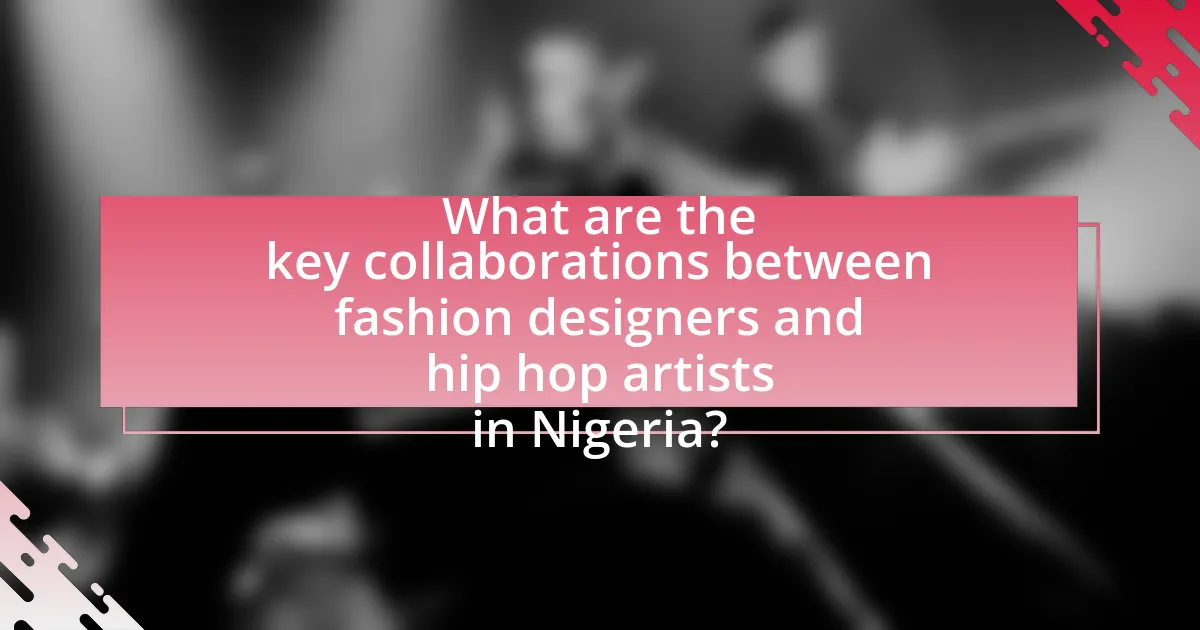
What are the key collaborations between fashion designers and hip hop artists in Nigeria?
Key collaborations between fashion designers and hip hop artists in Nigeria include the partnership between designer Mai Atafo and artist Olamide, where Atafo created custom outfits for Olamide’s performances, showcasing a blend of traditional and contemporary styles. Another significant collaboration is between designer Tolu Bally and artist Wizkid, who has worn Bally’s designs in music videos and public appearances, enhancing the visibility of Nigerian fashion on global platforms. Additionally, the collaboration between designer Yomi Casual and artist Phyno has resulted in unique streetwear that resonates with the hip hop culture in Nigeria. These collaborations highlight the synergy between fashion and music, driving trends and cultural expression within the Nigerian hip hop scene.
How do these collaborations shape public perception of both fashion and music?
Collaborations between fashion and music significantly shape public perception by creating a cultural synergy that enhances the visibility and appeal of both industries. In Nigeria’s hip hop scene, artists often partner with fashion designers, leading to a fusion of styles that resonates with youth culture and trends. For instance, when prominent Nigerian musicians wear local designers, it elevates the designer’s brand while simultaneously reinforcing the artist’s image as a trendsetter. This mutual reinforcement is evident in events like Lagos Fashion Week, where musical performances by hip hop artists attract attention to fashion showcases, thereby increasing audience engagement in both realms. Such collaborations also influence consumer behavior, as fans are likely to emulate the styles of their favorite artists, further intertwining fashion and music in the public consciousness.
What are some notable examples of successful collaborations?
Notable examples of successful collaborations in Nigeria’s hip hop scene include the partnership between fashion designer David Tlale and rapper Nasty C, which showcased a blend of streetwear and music culture. Another significant collaboration is between the artist Wizkid and the fashion brand Dolce & Gabbana, highlighting the intersection of luxury fashion and contemporary music. Additionally, the collaboration between rapper Olamide and the clothing line YBNL Nation has successfully merged music with local fashion trends, further solidifying the relationship between these two creative industries. These collaborations demonstrate how fashion and music can synergize to create impactful cultural expressions in Nigeria.
How do these partnerships influence the fashion industry in Nigeria?
Partnerships between musicians and fashion brands significantly influence the fashion industry in Nigeria by driving trends and increasing brand visibility. These collaborations often result in unique clothing lines that reflect the cultural identity and creativity of the hip hop scene, appealing to a younger demographic. For instance, artists like Wizkid and Burna Boy have partnered with international brands, which not only elevates their personal brand but also showcases Nigerian fashion on a global stage. This visibility has led to a surge in local designers gaining recognition, as seen in the rise of brands like Orange Culture and Maki Oh, which have benefited from the exposure provided by these partnerships.
What challenges do artists face in merging fashion and music?
Artists face several challenges in merging fashion and music, particularly in Nigeria’s hip hop scene. One significant challenge is the cultural perception of fashion as superficial, which can undermine the artistic integrity of musicians who wish to express themselves through style. Additionally, financial constraints often limit artists’ ability to collaborate with fashion designers or invest in high-quality clothing, impacting their overall presentation. The fast-paced nature of both industries can also lead to difficulties in maintaining a cohesive brand identity, as artists must constantly adapt to changing trends in both music and fashion. Furthermore, navigating the complexities of intellectual property rights can pose legal challenges when artists seek to incorporate fashion elements into their music videos or performances.
How do economic factors affect fashion choices in the hip hop scene?
Economic factors significantly influence fashion choices in the hip hop scene by dictating the affordability and accessibility of clothing brands. For instance, artists and fans often gravitate towards streetwear and luxury brands that reflect their economic status, with many opting for affordable alternatives to high-end fashion due to budget constraints. This trend is evident in Nigeria, where the hip hop community frequently showcases local designers and thrifted clothing as a response to economic limitations, promoting a unique blend of style that resonates with their financial realities. Additionally, the rise of social media has enabled artists to leverage their economic circumstances to create trends that align with their audience’s purchasing power, further shaping fashion choices within the scene.
What societal perceptions impact the relationship between fashion and music?
Societal perceptions significantly impact the relationship between fashion and music by shaping trends, identity, and cultural expression. In Nigeria’s hip hop scene, fashion is often viewed as a reflection of social status and artistic credibility, influencing how artists present themselves and their music. For instance, the adoption of specific styles, such as streetwear or traditional attire, can signal alignment with particular cultural movements or social messages, thereby affecting audience reception. Additionally, the perception of fashion as a form of rebellion or empowerment in music can drive artists to adopt bold styles that challenge societal norms, further intertwining the two domains. This dynamic is evident in the rise of artists who use fashion to express their individuality and connect with their audience, reinforcing the idea that fashion is not merely an accessory but a vital component of musical identity and cultural dialogue.

How can emerging artists navigate the intersection of fashion and music in Nigeria’s hip hop scene?
Emerging artists can navigate the intersection of fashion and music in Nigeria’s hip hop scene by actively integrating their personal style into their musical identity. This integration is crucial as fashion plays a significant role in shaping an artist’s brand and public perception. For instance, artists like Olamide and Nasty C have successfully used unique fashion choices to enhance their musical narratives, creating a strong visual identity that resonates with their audience. Additionally, collaborating with local fashion designers can provide artists with authentic representation and support within the industry, further solidifying their presence in both music and fashion. This approach not only fosters creativity but also builds a community that values the synergy between these two cultural expressions.
What strategies can artists use to develop their unique style?
Artists can develop their unique style by experimenting with various influences and techniques while maintaining authenticity. This involves exploring different genres, collaborating with diverse artists, and incorporating personal experiences into their work. For instance, Nigerian hip hop artists often blend traditional cultural elements with contemporary fashion and music styles, creating a distinctive sound and aesthetic that resonates with their audience. This approach not only showcases their individuality but also reflects the rich cultural tapestry of Nigeria, making their art more relatable and impactful.
How can social media be leveraged to enhance fashion visibility?
Social media can be leveraged to enhance fashion visibility by utilizing platforms like Instagram, TikTok, and Twitter to showcase fashion trends, engage with audiences, and collaborate with influencers. These platforms allow fashion brands and designers to reach a wider audience through visually appealing content, such as photos and videos, which can generate significant engagement. For instance, a study by the Pew Research Center found that 72% of teens use Instagram, making it a prime platform for fashion visibility. Additionally, collaborations with popular influencers can amplify brand reach, as influencers often have dedicated followings that trust their recommendations, leading to increased brand awareness and sales.
What role does networking play in building a fashion-forward image?
Networking is crucial in building a fashion-forward image as it facilitates connections with influential figures in the fashion and music industries. These connections can lead to collaborations, exposure to new trends, and access to exclusive events, which are essential for establishing a contemporary style. For instance, artists in Nigeria’s hip hop scene often leverage their networks to partner with fashion designers, thereby enhancing their visibility and credibility in both domains. This synergy not only amplifies their personal brand but also influences the broader fashion landscape, as seen in the rise of streetwear trends that merge music and fashion.
What are the best practices for artists to maintain authenticity in their fashion choices?
Artists can maintain authenticity in their fashion choices by staying true to their personal style and cultural roots. This involves selecting clothing that reflects their identity, influences, and experiences, which resonates with their audience. For instance, many Nigerian hip hop artists incorporate traditional fabrics and styles into their outfits, showcasing their heritage while also embracing contemporary trends. This blend not only highlights their individuality but also fosters a connection with fans who appreciate the cultural significance behind their fashion. Additionally, artists should avoid following fleeting trends that do not align with their personal brand, as this can dilute their authenticity and alienate their core audience.
How can artists balance personal style with commercial appeal?
Artists can balance personal style with commercial appeal by integrating their unique aesthetic into marketable trends. This involves understanding current fashion dynamics while maintaining authenticity, allowing artists to resonate with their audience. For instance, Nigerian hip hop artists like Olamide and Wizkid successfully blend traditional elements with contemporary styles, appealing to both local and global markets. This strategy not only showcases their individuality but also aligns with consumer preferences, demonstrating that personal expression can coexist with commercial viability.
What tips can help artists stay true to their roots while embracing fashion trends?
Artists can stay true to their roots while embracing fashion trends by integrating traditional elements into their contemporary styles. This can be achieved by incorporating local fabrics, patterns, and cultural symbols into their outfits, which not only honors their heritage but also resonates with their audience. For instance, Nigerian hip hop artists often blend traditional attire, such as the agbada or dashiki, with modern streetwear, creating a unique fusion that reflects both their cultural identity and current fashion trends. This approach not only maintains authenticity but also showcases the richness of their cultural background, making it relevant in the global fashion landscape.
